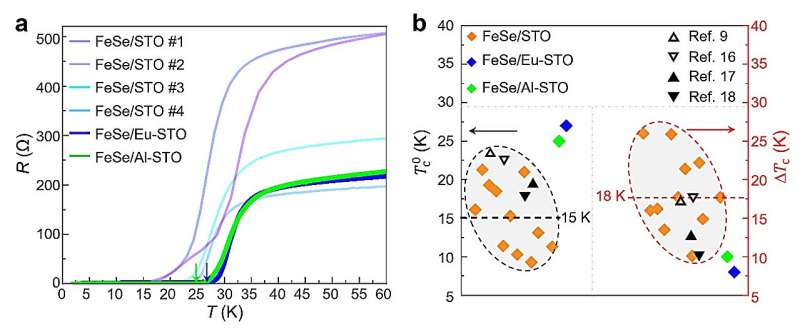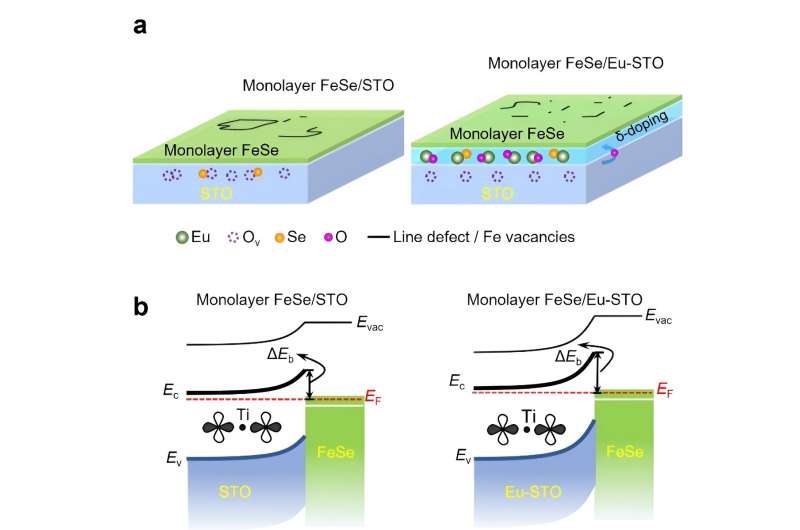Fig. 1 The transport results of FeSe/δ-doped SrTiO3(001), in comparison with FeSe/SrTiO3(001). Credit: Science China Press
Interface engineering has been proven to be effective in discovering new quantum states, such as topological states, superconductivity, charge density waves, magnetism, etc., which require atomic-scale heterostructure fabrication. Monolayer FeSe on SrTiO3 substrates has attracted intense interest owing to its remarkable interface-enhanced superconductivity.
Previous experimental investigations disclosed significant interfacial electron transfer to the FeSe monolayer, from the TiO2-δ charge reservoir layer with oxygen vacancies as the intrinsic donors. Moreover, the monolayer FeSe exhibits additionally enlarged gap magnitudes than other electron-doped FeSe (i.e., 15–20 meV vs. 12 meV), which has been attributed to the cooperative contribution from electron-phonon coupling with specific longitudinal optical phonon modes from TiO2-δ surfaces.
Incoherent Cooper pairing and pseudogap have been claimed because of the remarkably lower zero-resistance temperature achieved hitherto than the gap-opening temperature (65-83 K). Previous scanning tunneling microscopy/spectroscopy characterization disclosed dense domains in the monolayer FeSe films, and the superconducting gaps are suppressed around domain boundaries and even vanished in nanometer-scales domains.
The domains originate from the low-temperature (105 K) antiferrodistortive phase transition in bulk-SrTiO3. Previous efforts on improving the uniformity in the monolayer FeSe are usually at the expense of weakening the interface coupling, or vice versa.
Fig. 2 . Schematic diagrams for structure and band alignment in FeSe/SrTiO3(001) heterostructures without/with δ-dopants. Credit: Science China Press
Qi-Kun Xue and Lili Wang from Tsinghua University and Minghu Pan from Shaanxi Normal University reported enhanced interface coupling as well as improved spatial uniformity in monolayer FeSe films on SrTiO3(001) via metallic δ-doping (Au and Al atoms), and hence, enhanced superconductivity.
The Al and Eu atoms with higher oxygen affinity than Ti scavenge oxygen from the TiO2-δ surface, thus increasing the density of the surface oxygen vacancies but preventing their clustering, as revealed by lowered work functions with reduced electronic variation. Monolayer FeSe films on such δ-doped SrTiO3(001) exhibit reduced intensity of domains and generally enlarged superconducting gaps, indicating the strengthened Cooper pairing with improved electronic homogeneity.
Consequently, the temperature-dependent resistivity measurements disclosed an onset transition temperature of 53 K and a zero-resistance temperature of 27 K. This work is published in the National Science Review, titled "Significantly enhanced superconductivity in monolayer FeSe films on SrTiO3(001) via metallic δ-doping." Xiaotong Jiao from Shaanxi Normal University), Wenfeng Dong, Dr. Mingxia Shi and Dr. Heng Wang from Tsinghua University contributed equally to this work.
More information: Xiaotong Jiao et al, Significantly enhanced superconductivity in monolayer FeSe films on SrTiO3(001) via metallic δ-doping, National Science Review (2023). DOI: 10.1093/nsr/nwad213
Provided by Science China Press

























